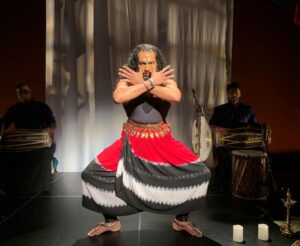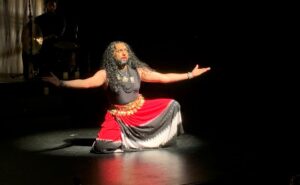The untold story of Kubera – Vaisravana

Adhering all the Covid-19 protocols, New Jersey based dancer, choreographer, writer, and educator Kiran Rajagopal recently performed his show Vaisravan in USA, which was well received by all. I spoke with the award winning Bharatanatyam dancer who has given many acclaimed performances in India, Indonesia, Germany, Spain, France, and the United States.
Tell me more about your dance training.
I received by early training in Bharatanatyam from Asha Prem, Prasanna Kasthuri, and Sujatha Srinivasan. Then I continued my advance training with A. Lakshmanaswamy and Bragha Bessell. I also studied Carnatic violin with A. Kanyakumari and Anusha Sreeram and Bhagavata Mela Natakam under the guidance of S. Natarajan. In 2017, I co-founded Daya Arts, a registered non-profit organization which aims to bridge diasporic communities of color through original, high-quality artistic productions rooted in West African and South Asian visual and performing arts.
What made you come up with this unique story?
This production was commissioned by Prakriti Dance, Maryland, USA for their “Festival of Villains” in October 2019. The premise of the festival was to highlight and examine characters from Hindu mythology who are framed as “villains.” I was asked by Prakriti Dance’s Artistic Director, Kasi Aysola, and Assistant Artistic Director, Ramya Sundaresan Kapadia, to create a production on Kubera. They initially wanted me to focus on Kubera’s “self-serving” nature especially in his relationship with Ravana.
Then how did this other side of the story come around?
In my extensive research on Kubera, I realized that there are two glaring issues with how Kubera is depicted in art and literature. The first is centered on his origins as a Yaksha from Sri Lanka (of indigenous/tribal “asura” origin). The second is on his shapeshifting between blackness (associated with greed and avarice) and whiteness (associated with generosity and nobility). South Asian society is often blatantly anti-Black and anti-indigenous – especially in how darker-skinned and lower caste people are depicted negatively in the media, art, and of course, mythology. This is reflected in the racist and cast ideology behind “asura” or “demon” referring to the Dravidian peoples of South India and Sri Lanka.
How did the name Vaisravana come about?
Sri Lanka is an important part of Kubera story because the destruction of the island at the hands of Hindu and Buddhist invasion is which drove Kubera to darkness. In Acts II and III, you will see Kubera as a subservient demi-god to the “Aryans,” and he plots his revenge against mankind. The pursuit of wealth becomes the real villain. I chose to name the production “Vaiśravaṇa” because that is the oldest formal name associated with Kubera (from the Atharva Veda). The most important aspect of this production was the script, and I worked with my theater director Michael Gardiner of Black Box Performing Arts Center in New Jersey, USA to fine-tune the script and to develop Kubera’s “voice” for the spoken parts.
How difficult was it to bring out a production during such times?
Thankfully, I had already presented Vaiśravaṇa in 2019 in full with live music for Acts II and III but with a recorded track for Act I with a Kandyan drummer. The script and the choreography for the entire production was more or less set prior to the pandemic, we had just completed the recording sessions with the musicians in Chennai, just a few days before lockdown was declared in the US and India. I was fortunate that all was in a way ready with me.
How did you feel performing after the lockdown?
I am happy that Ramapo College selected Act 1 of Vaiśravana for their Made in New Jersey series, they were keen on having live music as part of the production. Dilhan Pinnagoda, who had worked on the Kandyan dance choreography and music with me in 2019, brought in Indika Udaya Kumara (his longtime collaborator and former teacher at Sri Lankan Dance Academy of New York) to be part of the production. Our first rehearsal was interesting as all of us felt “rusty” because we had not performed live in more than a year. But the moment I started to dance I felt the tremendous energy that can only come from live music. Thankfully, there were only three of us on the Berrie Center’s large stage, and the set was designed to have plenty of room to allow for social distancing.
At the same time, I had to rethink the stage blocking for the production for the pre-recorded video format so that the choreography could be captured by multiple cameras. Michael Gardiner and I also re-worked the spoken word segments so that it made sense to the cameras. I think those changes enhanced the impact of the script and heightened the drama of the story even more. Wesley Beeks, the production’s set designer, also re-designed the stage set completely to look like a “Himalayan temple in the sky” with the amazing assistance of Ramapo College’s stage crew. But the most important inclusion into the production was the incredible lighting by Rachel Budin.
What is next on your mind?
It all dependent on how the pandemic proceeds, I am working on a dance-theater piece that is directly inspired by the pandemic which I will be starting to write shortly. This will be a more contemporary piece in terms of music and movement. I am also going to continue my research on the Nāstika schools of Hinduism (the heterodox schools of thought – some of which are atheistic and largely “lost” to history) to reconfigure a lecture-performance I did before. I would also like to finish choreographing the mārgam pieces I had started prior to the pandemic for my personal repertoire and for teaching students. So, there’s a lot to do, but I’m not in a rush let our lives get back to the old normal.
Sandip Soparrkar holds a doctorate in world mythology folklore from Pacifica University USA, an honorary doctorate in performing arts from the National American University, He is a World Book Record holder, a well-known Ballroom dancer and a Bollywood choreographer who has been honored with three National Excellence awards, one National Achievement Award and Dada Saheb Phalke award by the Government of India. He is also the recipient of the prestigious Rabindranath Tagore Prize for Social Achievement. He can be contacted on sandipsoparrkar06@gmail.com



